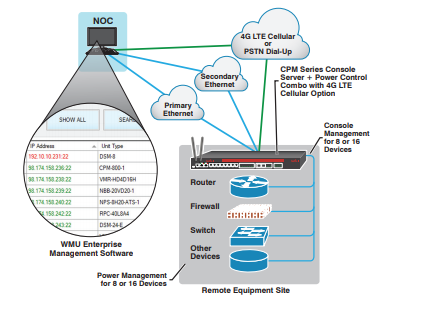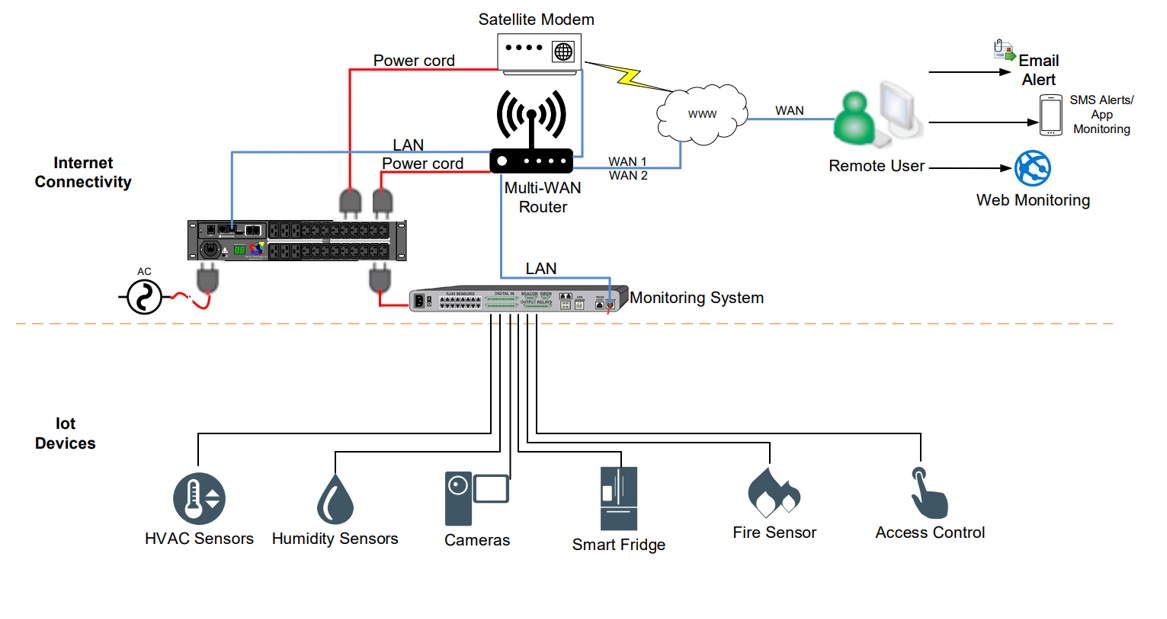IoT and Remote Monitoring
Internet of things can be seen as interconnectivity of smart devices. IoT devices have sensors and software that enable the collection and exchange of data via the internet. These objects can include humidity sensors, water sensors, temperature sensors, cameras, and even smart fridges (Check out these telemetry sensors). IoT objects can be controlled remotely to allow direct integration with monitoring and computer systems. This is where remote terminal units (RTUs) come in.
RTUs have the capability to interface the sensors with different I/Os and connectivity to the internet for sending and receiving data from the cloud or monitoring systems. For purpose of redundancy, they usually have multi-WAN connectivity. For instance, the WTI CPM-800 have two ETH-WANs and a 4G cellular connectivity for cloud communications. Other RTUs that can be used include the Redlions, and Sierra Wireless.

With IoT application, smart homes, businesses or smart farms can become easy to manage. Imagine a smart fridge communicating directly to retail stores for delivery of food items (depending on set parameters), and all we have to do is approve payments and monitor delivery. Offices can utilize IoT to monitor power usage and other utilities reports which can be used for better planning and optimization using other applicable sensors or manual commands from a NOC personnel.
All these monitoring and controlling can be done at the comfort of our desks or on our smart phones with remote control/monitoring devices. With IoT, it is highly likely we can improve efficiency of users.
Contact an RfWeL wireless and remote control specialist to learn more about how you can implement remote monitoring in various applications/projects. You may also reach us at +1.480.218.1877 Option 2.
Related Articles
Dynamic Spectrum Sharing and Its Meaning to IoT Systems
DSS refers to spectrum sharing between LTE technology and the newly introduced 5G New Radio. Apart from spectrum, they also share modulation schemes. Spectrum below the 6Ghz is in short supply. Therefore, governments are trying to allocate new ...LoRaWAN Application in Wireless IoT
LoRaWAN is a low-power wide-area (LPWAN) wireless application protocol that connects IoT devices (battery-powered) to the internet for monitoring and visualization on cloud platforms. LoRaWAN network architecture is deployed in a star-of-stars ...Simple wireless level monitoring solution for both small scale and industrial applications
Solution for monitoring water tank levels at home, with automated pump controller to ensure main tank is well supplied. Solution includes a wireless transmitter and a level sensor at the tank and a wireless receiver/gateway at the house. A pump ...Wireless Level Indicator System Solution
Featured in this article: Smart Water Wi-Fi Starter Pack (Sensor, Transmitter & Gateway) - SW900-STARTER-D Antenna Kit for Inseego Skyus 160 LTE Cellular Router - RFWY12-SK160NE-ACR-050 (Consider other device antenna kits for other cellular devices) ...Difference Between LoRa and LoRaWAN
LoRa is a wireless modulation technique derived from Chirp Spread Spectrum (CSS) technology (which employs use of chirps pulses). Check below AM, FM, and Chirp analog and digital modulation In digital transmission, the results of the modulation are ...
